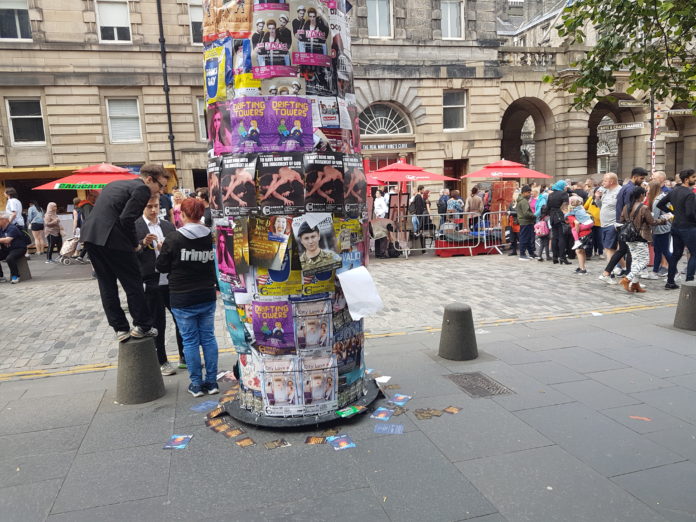During Edinburgh’s Fringe Festival, the number of people swarming the streets expands. Drastically. A city, normally of approximately 400 thousand, doubles through most of August, and it is easy to see why.
In 2017 there were 2.69 million tickets sold at the event, with people lining up to see just some of the 53,232 performances occurring throughout Edinburgh.
Unfortunately though, unless visitors have a time machine and unlimited spending money, there’s no way they can see all these shows, and the artists themselves are acutely aware of this.
To get around this, performers hand out flyers to promote their work, which is somewhat of a tradition at Fringe. This grass roots method is reasonably cheap, simple and is a great way for entertainers to proactively engage with the public.
But as popular as this strategy is, it doesn’t come without flaws. The amount of rubbish created at Fringe is enormous. Bins quickly overflow and the streets pile up with thrown aside litter, flyers included.
All this mess may not have been a problem too long ago, but recently things have changed.
By 2020 Edinburgh aims to reduce energy consumption by 14% in all major sectors. These efforts are partly due to UN policies, which have urged quick action to mitigate and adapt against climate change, and the city intends to cut CO2 emissions by 40% before 2020.
With sustainability goals now of paramount importance, is all this waste really necessary?
The issue with paper production is that it is an energy intensive process.
A 2016 report led by Climate Strategies and DIW Berlin suggests that European Pulp and Paper Industries are using 13.3 Gigajoules (3.69 megawatts) of energy per tonne of paper produced. This is just below the average energy use of a UK household in a month. There are also toxins produced as a side effect of paper production, particularly during pulping and bleaching, which can add to air, water and land pollution.
Fortunately CO2 emissions from European Pulp and Paper Industries are relatively low. 55% of the production energy comes from biomass and 38% from natural gas. Many of the fibres used to create the pulp comes from recycled paper, which greatly minimises waste to landfill.
Even so, increased efforts of sustainability at Fringe are essential if Edinburgh is to achieve its 2020 goals. Reduced flyering would cut down on unnecessary paper production emissions, transportation emissions, toxic waste and would go a long way towards keeping Edinburgh streets clean.
This being the case there are now innovative strategies Fringe organisers can use to reduce flyer waste and other rubbish, while still maximising promotion for performers.
Mobile apps are just one simple way of achieving this. Many individuals use their mobiles to find information on everything. If there was an app that had information on all upcoming shows, there would be little need for people to pick up flyers around every corner.
Digitization can also reduce the need for flyering if utilized by the performers themselves. For instance, it is recommended to artists that they use a diverse range of marketing strategies to attract visitors. This includes poster advertising, social media, press releases, online advertising and other marketing methods. Indirectly this means the need for flyer advertising could decrease substantially.
There are also incentives offered by Fringe Festival, which go a long way towards promoting sustainability practices. The Green Arts Initiative encourages performers to engage in environmental activities.
Working with this scheme in mind, artists may use reusable props during their show, travel more sustainably through use of public transport or a bicycle, and may even use recycled paper for their flyers.
Performers who participate in the initiative also have the chance of competing for the Fringe Sustainability Practice Award. Since first introduced in 2010, winners of the award have been innovative in their attempts to spread environmental awareness.
 Towers of Eden sketch by Outland Theatre. Winning show of Sustainability Practice Award 2017
Towers of Eden sketch by Outland Theatre. Winning show of Sustainability Practice Award 2017
So with great efforts being made to move towards digitization and to encourage green practice, what can be done to reduce the need for flyering on a more practical level?
Extra bins are one simple way of decreasing street litter, which is done every year at Fringe. But this could be taken a step further if incentives were offered to the public.
At some festivals, waste levels are kept low through reuse or clean-up initiatives. As an example the Stepping Stones Festival hands out reusable cups to all festival goers on arrival. On departure if they return their reusable cup they get the deposit back, and this method works well.
Other festivals hand out rubbish bags to all attendees, again offering an incentive of a deposit reimbursement if the rubbish bag is returned full when they leave the event. One rubbish bag is not much, but when everyone contributes this can make the clean up process extremely efficient.
If Fringe Festival were to offer similar incentives to the public, this could substantially reduce flyer waste. For example a payment schemes if a certain number of flyers were returned to the show.
But overall it seems like the festival organisers are well on their to making Fringe a green event, with sustainability practices being promoted heavily. The diverse marketing opportunities through digitization are also decreasing the need for flyering, and its not inconceivable that the festival may one day be paperless.
If there were incentives for the public to pick up rubbish and flyers, this could potentially cut out street litter altogether.
 Matthew Turner is an Environmental writer based in Eastbourne.
Matthew Turner is an Environmental writer based in Eastbourne.
